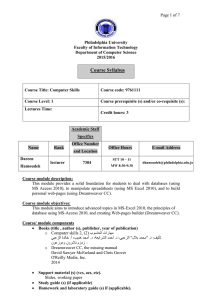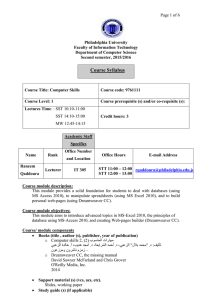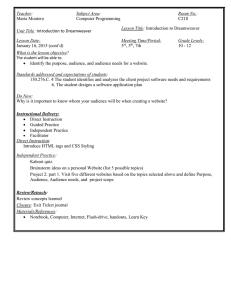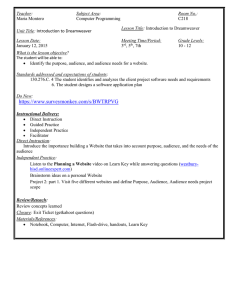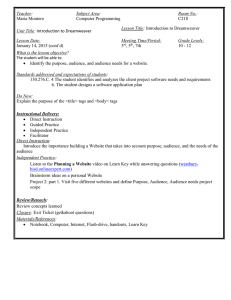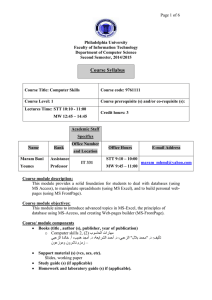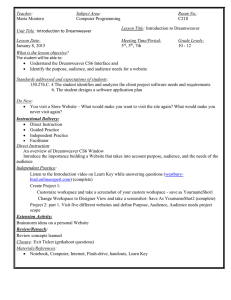Page 1 of 7 Philadelphia University Faculty of Information Technology
advertisement
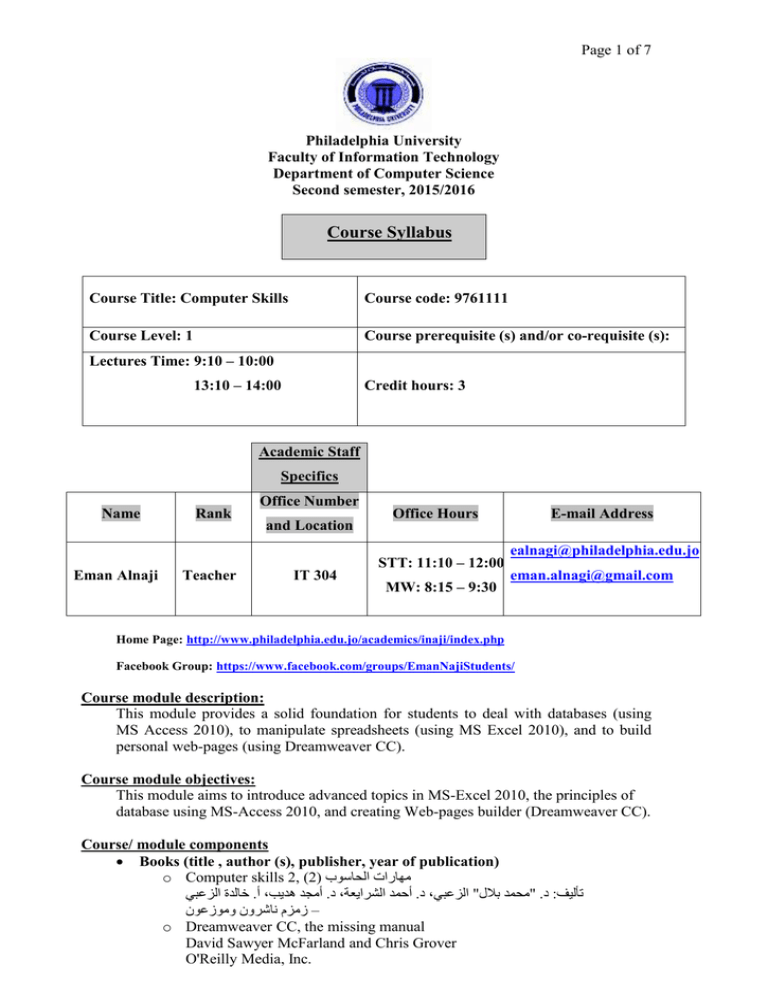
Page 1 of 7 Philadelphia University Faculty of Information Technology Department of Computer Science Second semester, 2015/2016 Course Syllabus Course Title: Computer Skills Course code: 9761111 Course Level: 1 Course prerequisite (s) and/or co-requisite (s): Lectures Time: 9:10 – 10:00 13:10 – 14:00 Credit hours: 3 Academic Staff Specifics Name Eman Alnaji Rank Teacher Office Number and Location IT 304 Office Hours STT: 11:10 – 12:00 MW: 8:15 – 9:30 E-mail Address ealnagi@philadelphia.edu.jo eman.alnagi@gmail.com Home Page: http://www.philadelphia.edu.jo/academics/inaji/index.php Facebook Group: https://www.facebook.com/groups/EmanNajiStudents/ Course module description: This module provides a solid foundation for students to deal with databases (using MS Access 2010), to manipulate spreadsheets (using MS Excel 2010), and to build personal web-pages (using Dreamweaver CC). Course module objectives: This module aims to introduce advanced topics in MS-Excel 2010, the principles of database using MS-Access 2010, and creating Web-pages builder (Dreamweaver CC). Course/ module components Books (title , author (s), publisher, year of publication) o Computer skills 2, )2( مهارات الحاسوب خالدة الزعبي. أ، أمجد هديب. د، أحمد الشرايعة. د، "محمد بالل" الزعبي. د:تأليف – زمزم ناشرون وموزعون o Dreamweaver CC, the missing manual David Sawyer McFarland and Chris Grover O'Reilly Media, Inc. Page 2 of 7 2014 Support material (s) (vcs, acs, etc). Slides, working paper Study guide (s) (if applicable) Homework and laboratory guide (s) if (applicable). Teaching methods: Lectures, discussion groups, tutorials, problem solving, debates, etc. Learning outcomes: A. Knowledge and understanding A3. Understand the principles and the use of various applications (MS Excel 2010, MS Access 2010 and Dreamweaver) Understand the fundamentals of Databases. Understand the principles of Web sites with their design. Learning advanced topics in Excel. B. Intellectual Skills B2. Design and implement a software system of significant size. Be able to design a database and designing small application screens using Access 2010 Be able to design an attractive GUI for websites using Dreamweaver Using Excel to develop electronic spreadsheets and applying formulas, charts of certain data. C. Practical Skills C1. Be able to plan and undertake an individual/group projects: Design a database and designing small application screens using Access 2010 Design an attractive GUI for websites using Dreamweaver Using Excel to develop electronic spreadsheets and applying formulas, charts of certain data. C6. Be able to use appropriate computer-based design support tools, such as help systems and notifications provided by the used software. D. Transferable Skills and Personal Qualities D2. Use and develop IT skills and mature computer literacy. D5. Display personal responsibility by working to multiple deadlines in complex activities. Learning Outcomes Achievement: Development: A3 is developed through the lectures (practical). B2, C1, C6, D2, D5 are developed through tutorials and homework. Assessment: A3, B2, C1, C6, D2, D5 assessed by quizzes, examinations, projects, homework and lab work. Page 3 of 7 Assessment instruments Short reports and/ or presentations, and/ or Short research projects Quizzes. Home works Final examination: 40 marks Allocation of Marks Assessment Instruments Mark First examination 20 Second examination 20 Final examination 40 Reports, research projects, Quizzes, Home 20 works, Projects Total 100 Documentation and academic honesty Documentation style (with illustrative examples) Submit your home work covered with a sheet containing your name, number, course title and number, and type and number of the home work (e.g. tutorial, assignment, and project). Any completed homework must be handed in to my office (room IT 306) by 15:00 on the due date. After the deadline “zero” will be awarded. You must keep a duplicate copy of your work because it may be needed while the original is being marked. You should hand in with your assignments: 1. A printed listing of your test programs (if any). 2. A brief report to explain your findings. 3. Your solution of questions. Page 4 of 7 For the research report, you are required to write a report similar to a research paper. It should include: o Abstract: It describes the main synopsis of your paper. o Introduction: It provides background information necessary to understand the research and getting readers interested in your subject. The introduction is where you put your problem in context and is likely where the bulk of your sources will appear. o Methods (Algorithms and Implementation): Describe your methods here. Summarize the algorithms generally, highlight features relevant to your project, and refer readers to your references for further details. o Results and Discussion (Benchmarking and Analysis): This section is the most important part of your paper. It is here that you demonstrate the work you have accomplished on this project and explain its significance. The quality of your analysis will impact your final grade more than any other component on the paper. You should therefore plan to spend the bulk of your project time not just gathering data, but determining what it ultimately means and deciding how best to showcase these findings. o Conclusion: The conclusion should give your reader the points to “take home” from your paper. It should state clearly what your results demonstrate about the problem you were tackling in the paper. It should also generalize your findings, putting them into a useful context that can be built upon. All generalizations should be supported by your data, however; the discussion should prove these points, so that when the reader gets to the conclusion, the statements are logical and seem self-evident. Bibliography: Refer to any reference that you used in your assignment. Citations in the body of the paper should refer to a bibliography at the end of the paper. Protection by copyright 1. Coursework, laboratory exercises, reports, and essays submitted for assessment must be your own work, unless in the case of group projects a joint effort is expected and is indicated as such. 2. Use of quotations or data from the work of others is entirely acceptable, and is often very valuable provided that the source of the quotation or data is given Failure to provide a source or put quotation marks around material that is taken from elsewhere gives the appearance that the comments are ostensibly your own. When quoting word-for-word from the work of another person quotation marks or indenting (setting the quotation in from the margin) must be used and the source of the quoted material must be acknowledged. 3. Sources of quotations used should be listed in full in a bibliography at the end of your piece of work. Avoiding plagiarism. 1. Unacknowledged direct copying from the work of another person, or the close paraphrasing of somebody else's work, is called plagiarism and is a serious offence, equated with cheating in examinations. This applies to copying both from other students' work and from published sources such as books, reports or journal articles. Page 5 of 7 2. Paraphrasing, when the original statement is still identifiable and has no acknowledgement, is plagiarism. A close paraphrase of another person's work must have an acknowledgement to the source. It is not acceptable for you to put together unacknowledged passages from the same or from different sources linking these together with a few words or sentences of your own and changing a few words from the original text: this is regarded as over-dependence on other sources, which is a form of plagiarism. 3. Direct quotations from an earlier piece of your own work, if not attributed, suggest that your work is original, when in fact it is not. The direct copying of one's own writings qualifies as plagiarism if the fact that the work has been or is to be presented elsewhere is not acknowledged. 4. Plagiarism is a serious offence and will always result in imposition of a penalty. In deciding upon the penalty the Department will take into account factors such as the year of study, the extent and proportion of the work that has been plagiarized, and the apparent intent of the student. The penalties that can be imposed range from a minimum of a zero mark for the work (without allowing resubmission) through caution to disciplinary measures (such as suspension or expulsion). Page 6 of 7 Course/module academic calendar Week MS-Excel (1) (2) ( 3) (4) Basic and support material to be covered Review basic concepts Advanced topics Pages ( 17 – 23 “Deleting Range Names”, 24-28 “Sorting Months and Weekdays”, 29-34, 36-37 “Paste Special”) Homework/reports 1. Report: Excel Usage 2. HW: building a expenses book using functions and charts Functions Pages ( 51 – 52, 54 – 64, 66-68, 73 “Logical Functions” – 76) Tutorial(1) Charts and advanced options - review charts basic concepts (How to insert chart) Pages ( 38 – 43, 46-47) Tutorial(2) MS-Access (5) (6): First exam (7) (8) (9) Introduction to Databases and DBMS Building a database using MS-Access Pages (96 - 104 ) Tables Pages (105 – 120, 122 ) Tables (continued) Pages (123 – 127, 131-136) Tutorial(3) Tables (continued) Pages (138 “Relationships” - 143, 144 “Deleting Relationships”– 145 ) Queries Pages (161 - 175) Tutorial(4) Forms Pages (146 – 153 “Deleting a form”) Reports Pages (176 – 179, 181 “AutoFormatting a report) 1. Reports: DBMS 2. HW: Create StudentRegistration process database with its query and required report Tutorial(5) Dreamweaver (10) (11): Second exam Introduction - Understanding the Adobe Dreamweaver CC Interface (Panels, workspace) - Create a webpage Working with Text Working with Links Tutorial(6) (12) (13) Working with Images, Videos and Sounds. Introducing Cascading Style Sheets (CSS) (14) (15) Working with tables Creating Forms * Publishing Web sites Tutorial(7) (16): Final Exam Review 1. Report: Web builders 2. HW: Building a personal web site Page 7 of 7 Expected workload: On average students need to spend 2 hours of study and preparation for each 50-minute lecture/tutorial. Attendance policy: Absence from lectures and/or tutorials shall not exceed 15%. Students who exceed the 15% limit without a medical or emergency excuse acceptable to and approved by the Dean of the relevant college/faculty shall not be allowed to take the final examination and shall receive a mark of zero for the course. If the excuse is approved by the Dean, the student shall be considered to have withdrawn from the course. Module references Books 1. Microsoft Office Access 2003 Professional Results , Noel Jerke, Mc Graw Hill, 2003. 2. Microsoft® Access Version 2007 Step by Step, Steve Lambert, M. Dow Lambert III, and Joan Preppernau, Online Training Solutions, Inc., 2007 . 3. Adobe Dreamweaver CC for Dummies, Janine Warner, John Wiley & Sons, Inc. 2013 4. Adobe Dreamweaver CC Digital Classroom, Michael Arguin, Greg Heald, and the AGI Creative Team, John Wiley & Sons, 2013. Websites 1. 2. 3. 4. http://www.plaxo.com/api/widget http://www.utoronto.ca/webdocs/HTMLdocs/NewHTML/intro.html http://www.frontpageworld.com/ www.microsoft.com/front page/
